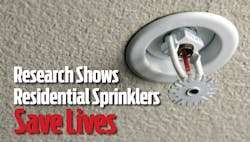Research Shows Residential Sprinklers Save Lives
Note: The following is adapted from “Preventing Fire-Related Occupational Deaths: Residential Sprinklers Save Civilians, Property, and Firefighters,” published in the Fire and Worker Health and Safety issue of the journal New Solutions, published by SAGE Journal (http://online.sagepub.com).
In 2012 alone, fire departments across the U.S. responded to an estimated 1.4 million fires, 78 percent of which occurred in the home. The impact of these fires was significant—2,855 civilian fatalities, 16,500 civilian injuries and an estimated $12.4 billion in property damage. Additionally, there were 69,400 firefighter injuries, approximately 45 percent of which occurred during firefighting activities. These significant impacts are mitigated with the use of residential sprinkler technology. While the benefits of this technology tend to center on civilian lives and property, there are also benefits for firefighters that are often overlooked. Here we describe those benefits and discuss the need for expanding the use of residential sprinkler systems as a strategy to reduce the risk of firefighter injury and death.
Impacts for firefighter safety and health
The connection between residential sprinkler systems and firefighter health was featured in the initial report from the 2004 Firefighter Life Safety Summit. Included was the recommendation to “strengthen the advocacy for the enforcement of codes and the installation of home automatic sprinklers,” as one of the 16 recommended initiatives to reduce firefighter injuries and fatalities by 50 percent in 10 years.
The National Fire Protection Association (NFPA) estimates a 65 percent reduction in firefighter injuries per 1,000 home fires when sprinklers are present. The power of residential sprinklers is that they stand ready 24 hours a day, seven days a week to extinguish fires before they can become a threat to civilians, firefighters and homes. The number and severity of injuries to civilians and firefighters can be significantly reduced with residential sprinkler systems.
Currently, residential sprinkler systems are present in an estimated 2 percent of one- and two-family homes, leaving much room for improvement. As we look for ways to reduce firefighter injuries and deaths, it is clear that residential sprinkler systems are a viable strategy for realizing this goal, and that firefighters have an important role in increasing the prevalence of residential sprinkler systems in the future housing stock.
A role for firefighters in promoting residential sprinkler systems
Whether to mandate residential sprinkler systems in new one- and two-family home construction is a topic of policy debate at the state and local levels. While California and Maryland have laws requiring sprinkler systems in all new home construction, several states have explicitly preempted local governments from legislating on this topic and other states have passed laws prohibiting state-level adoption of sprinkler mandates for new one- and two-family homes.
Some areas are bypassing these restrictions by using innovative strategies to promote the installation of residential sprinkler systems. One example is Mesa, AZ’s, creative allocation of federal grant money. The Neighborhood Stabilization Program (NSP), funded by Title III of the Housing and Economic Recovery Act, provides federal funding to states and local governments to acquire foreclosed or abandoned homes and rehabilitate, resell, or redevelop them in order to stabilize neighborhoods and stem the decline in home values. As a means of leveraging the benefits of this program to promote fire safety, Mesa made the decision to include the installation of residential fire sprinklers in all projects funded by the Neighborhood Stabilization Program. Since 2009, this measure has allowed Mesa to install fire sprinkler systems in 39 single-family homes and 10 multi-family properties in areas that carried a higher house-fire risk relative to the rest of the city. Once rehabilitated, the homes were sold to low- to moderate-income buyers and rental units were leased to very-low-income persons at below-market rates.
While the benefits of these sprinklers are clear, some policymakers, and even some firefighters, have expressed concerns about residential fire sprinkler systems. Those opposed to sprinkler mandates often describe them as too costly; however, recent national estimates put the cost of these systems at $1.35 per square foot. While the reasons some firefighters oppose the widespread adoption of residential sprinkler systems are not clearly documented, one possibility is a concern that residential sprinkler mandates could make firefighters and the fire service obsolete. While the potential of residential sprinkler systems to dramatically reduce fire damage is real, the risk of this intervention eliminating the need for the fire service is zero. Firefighters spend a significant portion of their time responding to motor vehicle crashes and other emergency and non-emergency incidents unrelated to residential fires. Unfortunately, we see no indication that the need for such responses is going away any time soon. We do see great potential in residential sprinkler systems for improving the occupational environment for firefighters while also dramatically reducing the toll of residential fires on the civilian population.
Conclusion
While advocates of residential sprinkler systems realize important successes in increasing the use of this technology, recent challenges to these efforts have stalled progress. With more than 1.2 million career and volunteer firefighters in the U.S., firefighters are an important voice for raising awareness about the existence of and benefits associated with residential sprinkler systems. To date, fire service leaders have been essential to the local ordinances and code changes that have led to many of the current sprinkler-equipped homes’ benefitting from those protections. The occupational health and safety benefits of the technology further strengthen the case for firefighter involvement in promoting greater use of residential sprinkler systems.
Additional support for efforts to increase the prevalence of residential sprinkler systems is needed. Whether that support comes in the form of public education about the benefits of residential sprinkler systems, advocacy to support residential sprinkler mandates, or creative programs, such as the one underway in Mesa, to include sprinkler systems in housing rehabilitation projects, there are roles for firefighters and their advocates in advancing this important life-saving technology.
To read the full text of the article, visit http://new.sagepub.com/content/24/4/475.long.
About the Author
Keshia Pollack
Keshia Pollack, Ph.D., M.P.H., is an associate professor in the Department of Health Policy and Management at the Johns Hopkins Bloomberg School of Public Health where she also serves as associate director of training and education for the Center for Injury Research and Policy.
Shannon Frattaroli
Shannon Frattaroli, Ph.D., M.P.H., is an associate professor in the Department of Health Policy and Management at the Johns Hopkins Bloomberg School of Public Health where she also serves as associate director of outreach of the Center for Injury Research and Policy.

